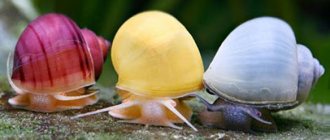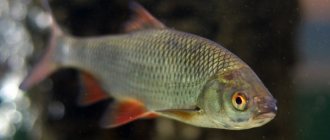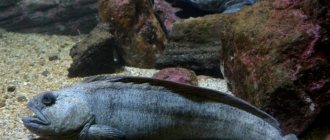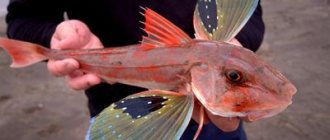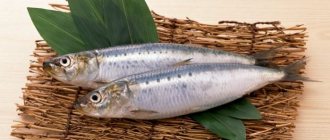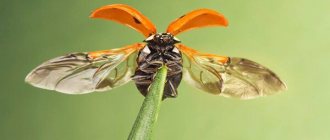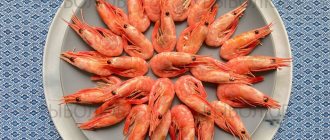Sand melania (lat. Melanoides tuberculata and Melanoides granifera), is a very common bottom aquarium snail, which aquarists themselves both love and hate at the same time. On the one hand, melania eat waste, algae, and perfectly mix the soil, preventing it from souring. On the other hand, they reproduce in incredible numbers and can become a real plague for an aquarium.
Habitat in nature
They originally lived in Southeast Asia and Africa, but have been accidentally introduced to many other tropical and subtropical areas around the world. Now melania live in an incredible number of different aquatic environments, in different countries and on different continents. This happened due to the carelessness of aquarists or through natural migration.
This snail feeds mainly on algae (microalgae).
Although it is a freshwater snail, the species is very tolerant of brackish water and has been recorded in waters with a salinity of 32.5 ppt (specific salinity 1.024).
What saves the situation is that melanias live only in countries with warm climates. It appears to prefer a temperature range between 18 and 25°C. Studies have been conducted to determine the lethal high temperature for a snail, which is around 50°C. This information is useful in disinfecting fishing gear and research equipment that may otherwise inadvertently spread snails into uncontaminated waters.
It is a fact that most snails end up in a new aquarium with plants or decorations, and often the owner does not even know that he has guests.
Appearance
The shell of the melania snail is conical, very durable, 27-35 mm long and the diameter of the mouth is 7-10 mm. The shell has 5-12 whorls with sculpted radial ribs and finer spiral tortuosity. Old specimens often lack the tip of the shell due to mechanical destruction or insufficient calcium in the water.
Shell color varies not only between species, but also within it. The main color is grey. Olive, greenish, and brown are mixed in with it in various proportions. Purple strokes are concentrated along the joints of the curls.
Closer to the mouth there are red-brown streaks, oriented along the longitudinal axis of the shell. The length, width, color saturation of the strokes, and the pattern they form are individual. There are individuals whose first curls are lighter in color than the rest. Not only the shape and color of the shell are different - there are dwarf subspecies of melania.
body is gray, brown or light beige in color and mottled with yellowish spots. The leg is short. The head is crowned with “horns”, which are organs of touch. At their base are the eyes . On the underside of the leg there is an operculum - a horny plate that, like a door, closes the entrance to the shell. The mollusk has well-developed olfactory organs. With the help of a keen sense of smell, the snail finds food.
Melania breathes through gills, so the mollusk, unpretentious to the characteristics of water, is sensitive to the level of oxygen in the water. It is a kind of indicator of the quality of the environment - with insufficient aeration, soil rotting, sharp fluctuations in the acid-base index, accumulation of decomposing organic matter, they move en masse to the upper layers, forming entire living garlands on the walls of the aquarium, decorative objects and plants.
Description
There are currently two species of melania in aquariums - Melanoides tuberculata and Melanoides granifera.
The most common is melania granifera, but essentially there is little difference between them all. It is purely visual. Granifera with a narrow and long shell, tuberculata with a short and thick one.
This species has an elongated, conical shell that is usually light brown in color and marked with rust-colored spots. The operculum is present. In some places, such as Israel, the shells are painted black or dark brown, probably to help hide the snail against the basalt cliffs of the Sea of Galilee.
The average shell length is about 20-36 mm, but exceptional specimens can be up to 80 mm long. Melania shells have 10-15 whorls
They spend most of their time buried in the ground, which helps aquarists because they constantly mix the soil, preventing it from souring. They crawl to the surface en masse at night.
Melanoides tuberculata and Melanoides granifera
Melania - who is she
The species Melanoides of the family Thiaridae, originally from Africa, gradually spread throughout Asian and Australian waters. Colonies of snails have been spotted in Mexico, Brazil, the southern states of the USA, and southern Europe.
The speckled gray body of the herbivorous gastropod is hidden in a conical shell 25–35 mm high with 5–7 spiral whorls. Color - light brown with a darker spire or dark brown with a black upper part. In times of danger and unfavorable conditions, the mouth of the shell is covered with a lime cap.
The structure of the melania is no different from other snails, but its cone-shaped shell sets it apart from other aquarium mollusks.
The body of the mollusk consists of a head, legs and torso, covered with a mantle, which secretes building material for the “house”. There are gills in the mantle cavity. The eyes are located at the base of two thin tentacles on the head.
Tactile communication between two melanias.
Snails do not hear or make sounds; they communicate with each other by touching.
Melanias live near the shores of freshwater or salty bodies of water with a slow current. But sometimes colonies of up to 1 thousand individuals per 1 sq. m. are found at a depth of 3–4 m. With an abundance of plant food and stones for shelter, communities of mollusks grow to 35 thousand.
To breathe, snails do not need to float to the surface; oxygen dissolved in the water is sufficient. In nature or artificial conditions, the lifespan of mollusks is 2 years.
Benefits and harms in an aquarium
- In fact, there is no harm from them. It is purely visual; when hundreds of melania crawl along the walls of the aquarium, this significantly spoils its appearance. That's all. They do not eat plants, do not attack fish, and do not notice shrimp. And in a balanced aquarium, most of the time is spent buried in the ground. If you are annoyed by their number, then you can read how to get rid of snails in an aquarium. They also create a very small bioburden on the aquarium, and even if they breed in large numbers, they will not affect the balance in the aquarium.
- The benefit of melania is that they mix the soil, thereby preventing it from souring and rotting. They eat rotten parts of plants and food residues that have fallen to the bottom.
How to control the number of individuals
To control the population, it is necessary to remove excess shellfish from the aquarium. But since they are nocturnal inhabitants, this must be done with cunning, that is:
- You can put a banana skin, only the black one, into the aquarium overnight, and in the morning take out the shellfish with it.
- You can envy the predators in the aquarium, then they will control the population; catfish, Helena snail or gourami are suitable for this.
- You can use chemicals, but then not only will the shellfish die, but the balance in the water will also be disrupted, and this will harm other inhabitants.
- You can turn off the air supply, then the mollusks will begin to crawl up, and it will be easier to collect them from the walls with your hands.
To prevent the mollusk from multiplying quickly, it should not create very favorable conditions for life; if it is limited in food, then reproduction will begin to slow down. This means that you will have to control its quantity less often.
These mollusks are frequent inhabitants of almost every aquarium. They can bring a lot of benefits and yet be invisible. The main rule in their maintenance is to control the reproduction and number of individuals. With proper care, they can become indispensable helpers.
Compatibility
Melanias are incredibly hardy and can survive in aquariums with fish that eat snails, such as tetraodon. They have a shell that is hard enough for Tetraodon to chew through, and they spend a lot of time in the ground, where it is impossible to reach them.
There is no need to talk about other fish that can eat snails (clown loach, macropod). Firstly, in an aquarium these fish prefer more tasty and accessible food, and secondly, the rate of reproduction of melania is such that it is simply impossible to eat them.
Reproduction
Melanias are viviparous snails. To obtain offspring, you must have a male and a female in the aquarium. The female bears eggs in the shell, and after a while tiny snails from 10 to 60 pieces are born. Immediately after birth, they burrow into the ground.
In a month, babies grow by 5-6 mm. From one pair of tuberculates, several dozen, or even more than a hundred babies can appear in the aquarium in a couple of months. But granifers will need about 8 months to create the same number of babies.
Keeping in an aquarium
Melania are quite common in freshwater aquariums, but opinion is divided between those who see them as pests and those who value their usefulness as algae eaters and soil cleaners.
Snails can live in any size aquarium, and in nature in any body of water, but they cannot survive if the climate is too cold.
It’s not for nothing that Melania is called sandy; it’s easiest for her to live in sand. But this does not mean that they cannot live in other soils.
In my place they feel wonderful in fine gravel, but in my friend’s aquarium there is practically no soil and with large cichlids. Things like filtration, acidity and hardness don't really matter, they'll adapt to everything.
In this case, you won’t even need to make any effort. The only thing they don’t like is cold water, as they live in the tropics.
Nutrition
These snails can also feed on soft-leaved plants.
The diet of melania is based on lower algae and semi-decomposed organic remains. Being typical detritivores (creatures that feed on decaying organic material), they will not refuse scalded lettuce, cucumber or zucchini, as well as leftover fish food.
With a lack of food, the growth and development of snails slows down. Nutrient deficiency slows down the reproduction process.
Feeding
There is no need to create any conditions for feeding; they will eat whatever is left of the other inhabitants. They also eat some soft algae, thereby helping to keep the aquarium clean.
If you want to feed additionally, you can give any tablets for catfish, chopped and lightly boiled vegetables - cucumber, zucchini, cabbage.
By the way, in this way you can get rid of an excessive amount of melania, give them vegetables, and then get the snails that have crawled onto the food.
The caught snails need to be destroyed, but do not rush to throw them into the sewer; there have been cases when they crawled back out. The simplest thing is to collect them in a bag and put them in the freezer.
Methods of disposal
The ability of snails to eat plants can, in some way, bring some benefit, but this is also the harm of the melania snail. Indeed, due to their strong gluttony, they can completely rid the aquarium of vegetation.
To prevent such an outcome, you need to monitor the number of mollusks. To do this you need:
- Introduce clams to Helen. Since these representatives of snails are predators, melania will be an excellent treat for them. This option does not incur any additional time costs, and also does not require any additional effort.
- Place a vegetable such as cucumber, zucchini or banana peel in the aquarium. At the end of the night, the entire surface of the vegetable will be covered with melania, after which the bait should be removed from the aquarium.
- Collecting snails by hand. This disposal option is considered the most ineffective. You should collect the snails, and after a certain period of time, you need to repeat everything again.
- You can turn off aeration in the aquarium. This method will cause a lack of oxygen at the bottom and the snails will be forced to rise to the top of the water space, after which they can be easily collected. However, caution should be exercised, since the lack of oxygen may also be felt by other inhabitants.
5 / 5 ( 1 voice )
Pond snail (Lymnaeidae)
Size up to: 5 cm. Is it needed in an aquarium? No, they have no benefit, but they can damage plants.
Our domestic pond fish (there are many types) can be seen floating on the surface of the water of lakes and ponds. Under no circumstances should you specially bring them into a tank with fish and plants. They will immediately eat plants, and they can infect fish with Trematode larvae. Description . The shell has a round, cone-shaped shape, strongly pointed towards the top, curled to the right. There are eyes on the outside of the flat triangular tentacles. The leg is short and wide. The body is gray-green, the shell is light yellow. They breathe with their lungs and therefore from time to time rise to the surface of the water for air.
U. Pokemon, Radix, P. Tropical
Water . Low temperature is more suitable. Nutrition . Pond fish eat a lot and are omnivores. Breeding . The caviar is attached to the underside of the leaf and is a gelatinous mass in the form of an icicle. Each icicle contains up to 100 transparent eggs. The baby hatches within a month.
Tropical pond snail (Radix rubiginosa)
Tropical pondweed (Radix Rubiginosa) is a tropical analogue of our domestic pondweed, size up to 1.5 cm. Otherwise called: Pokemon, Radix. Origin: Malaysia and Indonesia (Borneo). There are several varieties of P. Tropical with different body and body colors. Light and transparent body shapes are the most decorative. Pokemon are quite omnivorous, prefer fouling, do not disdain even blue-green algae, love rotten leaves, and live plants are the last thing they touch. Radixa are hermaphrodites and produce offspring without any problems.
Negative points
Snails help in maintaining an aquarium by performing various useful functions. However, “helpers” require close attention - in favorable conditions they multiply like on an assembly line, and from allies they can turn into enemies. Excessive shellfish populations lead to:
- Total eating of plants.
- Spread of parasites.
- Spread of infections.
- Creating obstacles to the development of other inhabitants.
- Reduced quality of water.
In addition to the organic matter that melania pick up from the bottom, they need additional feeding to avoid the destruction of algae. Bottom food for catfish is well suited for this purpose. And in the absence of the required component, chopped fresh herbs or vegetables may be suitable.
